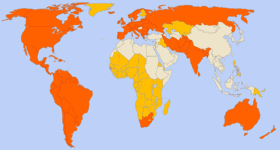 Countries with IE languages majority in orange. In yellow, countries in which have official status. [© gfdl]
Countries with IE languages majority in orange. In yellow, countries in which have official status. [© gfdl]
1. The Indo-European languages are a family of several hundred languages and dialects, including most of the major languages of Europe, as well as many in South Asia. Contemporary languages in this family include English, German, French, Spanish, Portuguese, Hindustani (i.e., mainly Hindi and Urdu) and Russian. It is the largest family of languages in the world today, being spoken by approximately half the world's population as their mother tongue, while most of the other half speak at least one of them.
2. The classification of modern IE dialects into languages and dialects is controversial, as it depends on many factors, such as the pure linguistic ones (most of the times being the least important of them), the social, economic, political and historical ones. However, there are certain common ancestors, some of them old, well-attested languages (or language systems), as Classic Latin for Romance languages (such as French, Spanish, Portuguese, Italian, Rumanian or Catalan), Classic Sanskrit for the Indo-Aryan languages or Classic Greek for present-day Greek.
Furthermore, there are other, still older -some of them well known- dialects from which these old language systems were derived and later systematized, which are, following the above examples, Archaic Latin, Archaic Sanskrit and Archaic Greek, also attested in older compositions and inscriptions. And there are, finally, old related dialects which help develop a Proto-Language, as the Faliscan (and Osco-Umbrian for many scholars) for Latino-Faliscan (Italic for many), the Avestan for Indo-Iranian or the Mycenaean for Proto-Greek.
NOTE. Although the proto-language groupings for IE languages may vary depending on different criteria, they all have certainly the same common origin, and that it is generally easier to reconstruct than the individual groupings. For example, if we had only texts of old French, old Spanish and old Portuguese, medieval Italian and modern Rumanian and Catalan; then Vulgar Latin (i.e., the features of the common dialects spoken by all of them, not the older, artificial, literary Classical Latin) could be easily [see Criticisms B.2] reconstructed, but the groupings of the derived dialects not. In fact, the actual groupings of the romance languages are controversial, even knowing well enough Archaic, Classic and Vulgar Latin...
 In green, majority of population speaking Indo-European languages. In dark green, Uralic language majority. In light brown, Turkic language majorities. [© gfdl]
In green, majority of population speaking Indo-European languages. In dark green, Uralic language majority. In light brown, Turkic language majorities. [© gfdl]